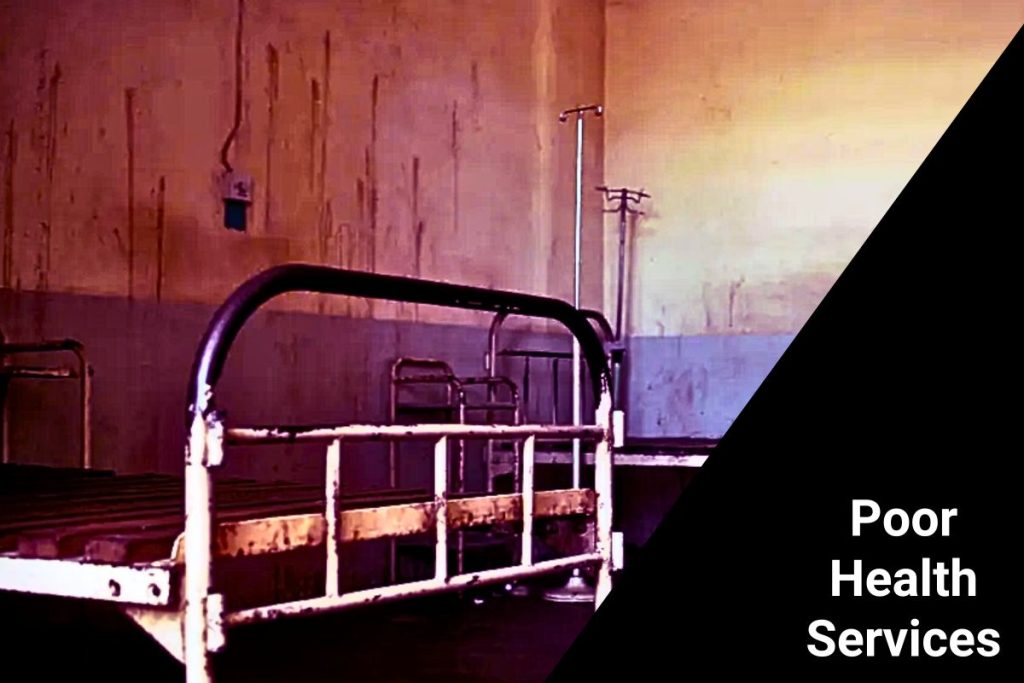Sanitation has done more to increase human life than all forms of medicine.
As you might expect by now, the Busoga region’s health sector is also deprived.
Sanitation is a critical component of human life, as it ensures dignity and helps prevent the spread of diseases, such as cholera, that have hindered and claimed many lives in the region.
The Health Sector Development Plan (HSDP) is the medium-term plan driving the agenda of a healthy life for all Ugandans, alongside the National Development Plan II (NDP II) and the National Health Policy (NHP II). One of the fundamental goals of the HSDP is to contribute to producing healthy human capital for wealth creation through providing equitable, safe, and sustainable health services.

The “district league score” is the performance score measured between regions or districts against key health indicators. The higher the score the better the rated performance (with 0 as the lowest score possible and 100 as the highest).
As reported by the Development Initiatives, Spotlight on Uganda, based on data from the Uganda Bureau of Statistics, Busoga region scores were lower against all health indicators than the national average. These metrics imply that the populations in the Busoga region experience poorer quality of health services than those in areas with better scores.
While in some cases, poor performance against development indicators correlates with higher poverty headcount and sanitation, the Busoga region score on household sanitation coverage was surprisingly above the national average. The region performed second best based on indicators of water, sanitation, and hygiene (WASH), as households in the Busoga region continued to have much lower levels of human capital, less asset ownership, and more limited access to infrastructure than households in other regions.

Health Facilities
Health facilities in Uganda include hospitals and health centres. It is recorded that the number of functional healthcare facilities owned by the government, private not-for-profit (PNFP), and private for-profit (PFP) increased, especially after 2015/16.
Although statistics show that the per capita public health expenditure has generally increased in the nation, the experience is different in Busoga.
As noted elsewhere in other critical socio-economic sectors, the distribution of functional healthcare facilities across the country is far from even. Forty-six per cent of the healthcare facilities are located in the central region. The Western region had the highest number of regional referral hospitals.
Human Resources
In the financial year 2016/17, the records showed that the countrywide approved percentage of posts with health facilities increased to 72% from 64% in 2015/16. Regional Referral Hospitals, Uganda Blood Transfusion Services, and the District Health Officer’s offices recorded the highest increase of 24, 37, and 30 percentage points, respectively. The Uganda Cancer Institute had the highest decline of 13 percentage points between the two financial years.
Expenditure on Health Sector
The noteworthy reasons they provided were:
- the health facilities are too far,
- the available health facilities are costly,
- the issue of drug stock-outs
- others considered their illness to be mild.
Available household expenditure on healthcare services significantly impacts one’s healthcare options, thus affecting the quality of life.
Costs such as transport to and from the health facility, consultation fees, and medicine and in-patient costs, among others, often pose a big challenge for financially vulnerable people.
The results also showed that most communities cited the unavailability of medicines/medical supplies, limited range of services, long waiting times, and under-staffing of the health facilities as some of the extensive concerns concerning accessing public health facilities.
Other factors that affect the quality of the region’s health fall under cultural and religious beliefs.
Sick people in poor areas find themselves overcrowded and waiting in long queues while visiting health centres. The poorer the community the higher the patient caseload.
This reality partly explains why there is such a low proportion of women delivered in decent health facilities under the attendance of specialized health workers in the Busoga region.

Accessibility of Toilet Facility
Improper disposal of human waste is a burden to public health provision. Proper disposal of human waste involves the use of a toilet facility.
The survey collected information on the types of toilet facilities that households mainly used.
The results showed that 83% of households used pit latrines while 7% used bushes/did not use any toilet facilities. About 1% used flush toilets.
Improved sanitation includes improved toilet facilities such as a flush toilet, VIP latrine, covered pit latrine with a slab, and Ecosan.
Solid Waste Disposal
The method through which households dispose of their solid waste can pose a risk to public health.
The most commonly used method of household solid waste disposal was in the garden (44%), followed by burning (23%). Others bury the waste, and some communities have small-scale local garbage dumps.

